Reaching Govardhana Hill
Govardhana Hill is 26 km (14 miles) west of Mathura. By car it takes about forty-five minutes to get to Govardhana Hill from Vrindavana. As Govardhana Hill and Radha Kunda are right next to each other, both can easily be visited on the same trip.
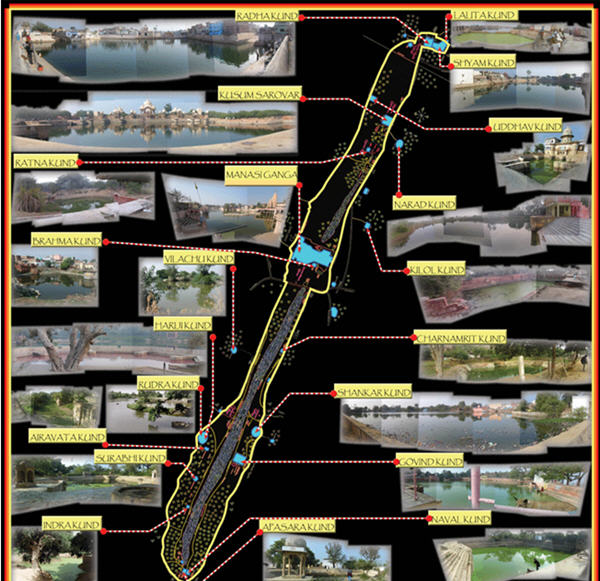
Parikrama
It is the form of worship to walk around Govardhana hill.
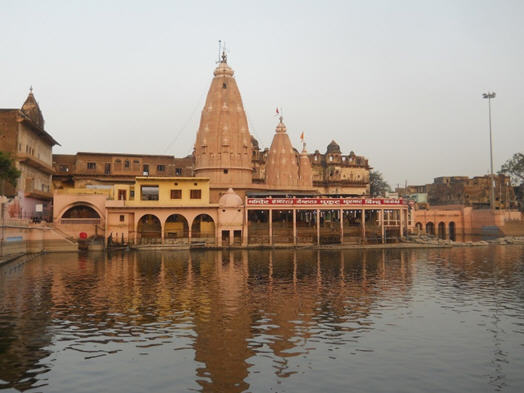
To the west of Mathura, at a distance of two yojanas, is Govardhana, the topmost Holy place. Anyone who performs its parikrama will never have to take birth in this world again. – Varaha Purana. Rupa Goswami stated in his Mathura mahatmya that one should first bathe in Manasi Ganga and then take darshan of Harideva before starting parikrama.
Instructions for Performing Parikrama
In Vraja bhakti the following instructions are found regarding parikrama of Govardhana Hill.
1. One should offer proper respect to all the Deities, cows, brahmanas, trees, creepers, rocks and kundas one sees.
2. One should not offend any living entity, moving or non-moving otherwise one will lose the benefits of his parikrama.
3. While performing parikrama one should not wear shoes or leather items and one’s cloth should be freshly washed.
4. One must observe brahmacarya and take bath as well as clean teeth before starting parikrama.
5. One should not perform parikrama at night.
6. While performing parikrama one should move carefully so as not to kill any living entities on the path.
7. If one becomes sick during parikrama one should stop and take rest, parikrama should be continued after health is regained.
8. One should not leave his parikrama uncompleted.
9. Women should not perform parikrama during their menstrual period.
10. One should not strain himself while performing parikrama.
The parikrama route around Govardhana hill is 25km. There is also a 40 km outer parikrama path. Sanatana Gosvami would do the outer parikrama while he was staying at Govardhana hill. The average person goes around Govardhana hill in six or seven hours.
1. Manasi Ganga
Mana means “mind” and Ganga is another name for the Ganges. Manasi Ganga kunda is traditionally the starting and ending point of the circumambulation of Govardhana Hill. Vraja-vilasa-stava text 64 by Raghunatha dasa Gosvami says “Manasi-ganga intensely enjoys the pleasurable taste of the boating pastimes of Gandharvika and Mura vimardana. With her plentiful waves, she pushes about piles of effulgent rocks from Govardhana Hill. May this lake give me protection”.
The beautiful celestial lake known as Manasi-ganga is the largest of all the sacred kundas found in the Vraja area. Situated right in the heart of Govardhana town, this lake was formerly much larger than it is today. Just as Govardhana Hill is shrinking in size every day, so is Manasi ganga. Manasi-ganga is considered to be nondifferent from the river Ganges. In fac, it is considered to be even better. One who bathes in the river Ganges is purified of all his sins, but one who bathes in Manasi-ganga is not only purified of his sins but will also achieve prema- bhakti, the highest platform of loving devotion to Sri Krsna.
The Appearance of Mansi Ganga
One day Krsna and Balarama, along with Their cowherd boyfriends, were tending the cows in the pasture grounds near Govardhana Hill. A demon of the name Vatsasura came there in the disguised form of a calf and with the evil intention of killing Krsna, mingled with the other calves. Krsna however, was aware that this demon was hiding amongst the calves, and He warned Balarama. The transcendental brothers then sneaked up behind the demon calf and Krsna grabbed him by his back legs, whipped him around with great force and threw him up into a nearby tree. The demon immediately gave up his life air and his dead body fell to the ground. On seeing this cowherd boys enthusiastically congratulated Krsna. Because Krsna had killed a demon in the shape of a calf, the cowherd boys asked Him to take His bath in the river Ganges in order to purify Himself. Not wanting to leave Vraja, Krsna informed the cowherd boys that He would call the river Ganges to appear in Vraja. Krsna then meditated and from within His mind the river Ganges manifested before Him in the form of Manasi-ganga. In other words, the Ganga manifested from the mind of Krsna. Krsna then took his bath to the great delight of all the cowherd boys.
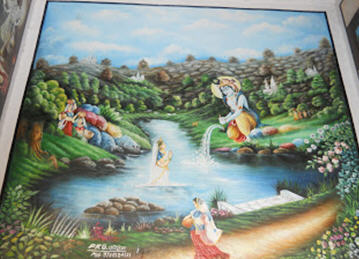
On another occasion Nanda Maharaja, mother Yasoda and the residents of Vrndavana heard a wonderful story about the glories of the river Ganges. They heard that Garuda, the carrier of Lord Visnu, had once captured a large snake near the banks of the Ganges. While he was flying away with the snake in his claws, the tail of the snake accidentally touched the water of the Ganges. Immediately the snake changed into a four-armed form like the residents of Vaikuntha. Amazed, Garuda placed the four-armed personality on his back and carried him all the way to Vaikuntha. Hearing about this wonderful story and the potency of bathing in the Ganges, all the residents of Vraja decided that they would make a pilgrimage to the river Ganges and take bath. Seeing the arrangements being made for the journey, Krsna informed Nanda and Yasoda that there was no need to go out of Vraja to take bath in the Ganges, as the Ganges was present in Vraja itself. However, Nanda Maharaja and the other Vrajavasis thought that as Krsna was just a small child and did not fully understand the matter. But Krsna kept insisting and finally Nanda Baba relented. Accompanied by all the inhabitants of Vrndavana, he followed Krsna to the middle of Govardhana Hill. When Krsna arrived at the shore of Manasi-ganga, Ganga Mata, the river Ganga personified, suddenly appeared from the water and offered prayers to the Lord. When all the inhabitants of Vrndavana saw Ganga Mata they offered their obeisances to her. Then, led by Nanda Maharaja, they all took their holy bath in the Manasi-ganga.
Pastimes in Manasi Ganga
Boat Pastime at Manasi Ganga: Srimati Radharani and the gopis came to the bank of Manasi Ganga and wanted to take a boat across. Manasi Ganga used to be a large lake, but has gotten much smaller over the years. They were carrying their yoghurt pots and other milk preparations. Unfortunately only one very old boat was available and the boatman was just a young boy dressed in a large cloak, with a peacock feather on his head. He agreed to ride them and they bargained for a while over the price. They settled that the price would be some sweets and butter.
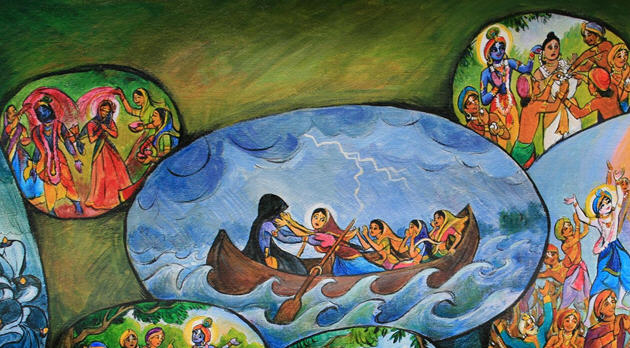
He rowed for a while and then just stopped. Srimati Radharani and the gopis asked Him why he had stopped. He told then that He was tired and hungry and He could not go any further unless they did not feed Him. In an angry mood the gopis refused, but when they saw he was not going to move, they relented and fed him milk sweets. He ate everything. He then told them that he would take a nap and that they should massage His arms and legs. They told Him if He did not keep rowing they would throw Him overboard. He then started rowing again. He then stopped again and the gopis asked Him why He had stopped. Pointing to the floor of the boat he told the gopis that his old boat was filling up with water and slowly sinking due to the heavy weight. The boatman also said that unless they threw all their heavy pots overboard, the boat would surely sink. Shocked to hear the words of the boatman, the gopis immediately threw their pots of yogurt and butter into the water. Then the boatman told them that the boat was still too heavy and that they should now throw all their jewellery into the water. Reluctantly, the gopis took off their beautiful jewellery and threw it into the water. The boatmen then told them that the boat was still too heavy and that they should take off all their clothing and throw that into the water as well. Infuriated at this latest suggestion, the gopis angrily informed the boatman that they would throw him into the water and that this would certainly solve the weight problem. Hearing this, the boatman again started rowing, but before he could get further, a storm appeared over the lake. Dark clouds covered the sky and a strong wind started to blow and the waves on the water became agitated. The boatman could see that Radharani and the gopis were looking very frightened that they might all drown. In order to diminish their fears, the boatman started to rock his boat back and forth to show its sturdiness. At that moment, terrified that She might fall into the water, Radharani leapt forward and thrust Her arms around the boatman for safety. As soon as She put Her arms around the boatman, She realized that He was none other than Her beloved Krsna in disguise. Suddenly the clouds cleared, the wind died down, the waves became calm, and the moon suddenly appeared in the evening sky. When all the cowherd girls saw Radharani embracing the boatman they inquired about the meaning of Her behavior. In answer to their inquiry, Radharani pulled Krsna’s flute from under His cloak. The gopis then realized that the boatman was actually the transcendental prankster Sri Krsna in disguise. Krsna then took Radharani and the gopis on a wonderful boat ride around all the different islands in the Manasi-ganga lake.
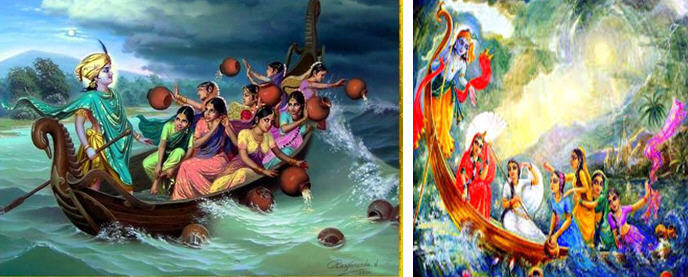
This pastime is described by Jiva Goswami in Gopal champu.
Manasi Ganga Area
There are several important places on the banks of Manasi Ganga or nearby. Close by is the Harideva temple, Manasi Devi temple, Brahma kunda and Chakra Tirtha.
Manasi Devi Temple
The Manasi Devi Temple is on the bank of Manasi Ganga.
Brahma Kunda.
The devi in this temple, Manasi Devi, is the presiding deity of Manasi Ganga and is one of the four main Devi temples in Braja Mandala. The other three important Devi temples are: Yoga Maya in Vrindavana, Patalesvar Devi in Mathura, and Vrinda Devi in Kamyavana. It is said that by praying at the feet of one of these goddesses, one may achieve an eternal position in the Vrndavana pastimes of Lord Sri Krsna.
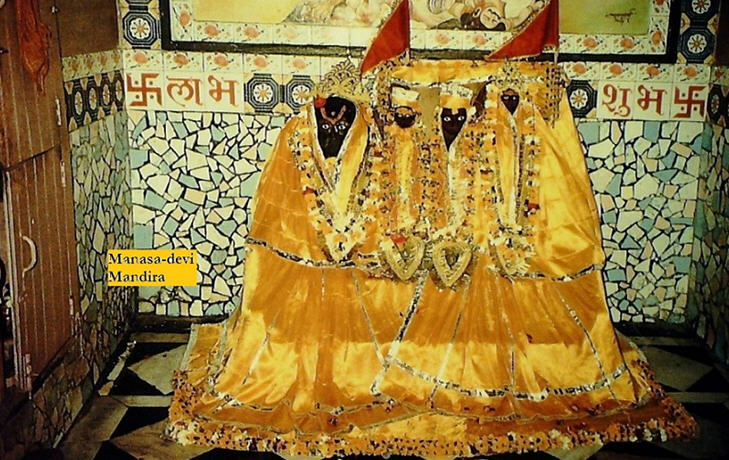
Reaching there:
If you just turn off the road from the parikrama road to go to Manasi Ganga, the Manasi Devi temple is on the left, up stairs, after about 100m. To get here after leaving the Harideva temple, you turn left after 1017 (30 ft), onto a path. You follow the path around for 20 seconds and the small temple is up a flight of stairs on the right.
Mukharavinda Temple
This majestic sandstone temple is situated on the banks of Manasi-ganga contains the lotus mouth of Giri-Govardhana. Mukharvinda means lotus mouth. Pilgrims visiting the temple bring offerings of milk and sweets to feed the Mukharvinda-sila. Gallons of milk are poured over this sacred Govardhana-sila every day. Although there are number of other silas that the local people claim to be the Mukharvinda, Srila Bhakti Siddhanta Sarasvati Gosvami has confirmed that this sila is actually the real Mukharvinda.
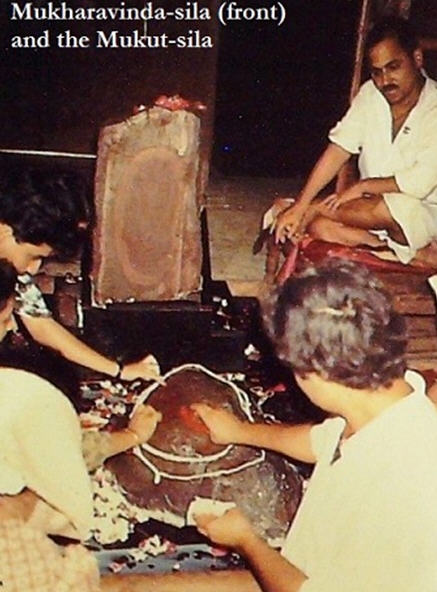
Just behind the Mukharavind-sila one can see standing upright the Mukut-sila. This sila is marked with the outline of Sri Krsna’s mukut (crown). The Vrajavasis traditionally end their parikrama of Govardhana hill by having darsana at the Mukharvinda temple and then go for a final dip in Manasi-ganga.
Chakra Tirtha
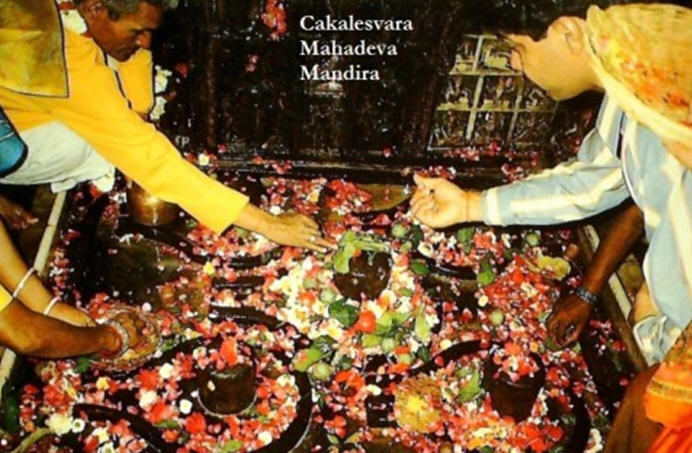
Chakra Tirtha, which was created by the Sudarsana Chakra, is embedded in the northern bank of Manasi Ganga. As Krishna was holding Govardhana Hill, torrents of rain were coming down. Krishna could see that the water would come under the hill and drown everyone. Therefore He had His Sudarsana Chakra stay above the hill for the entire seven days. The Sudarsana Chakra produced heat equal to many suns which consumed all the rain. Also Sesa Naga came and drank up the rain water. After Krishna repositioned Govardhana Hill, the Sudarsana Chakra remained on the northern bank of Manasi Ganga. That place is called Chakra Tirtha. The Chakra (disc) of Lord Vishnu is called Sudarshana which means “auspicious vision.” The illuminating principles in this world such as the sun, the moon and fire emanate from the effulgence of Sudarsana. Similarly, illumination by knowledge also comes from Sudarsana because with the illumination of Sudarsana one can distinguish one thing from another, the superior from the inferior. At Chakra Tirtha, Radha and Krishna are said to have had first swing pastime.
Reaching there:
This is the area where the Chakaleswara Mahadeva temple is located.
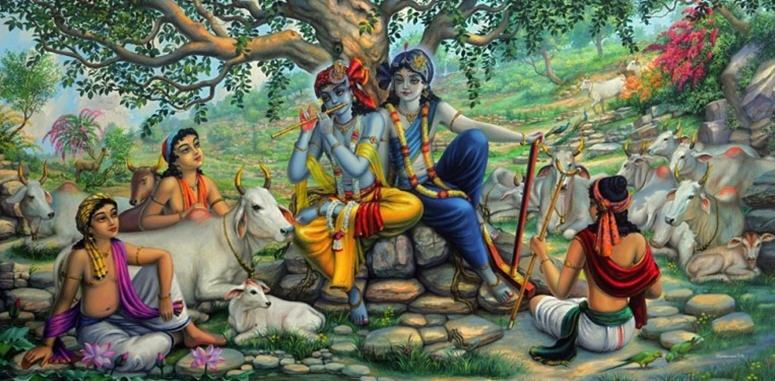
Chakaleswara Mahadeva temple and Sanatana Gosvami’s Bhajana Kutir:
Next to the bhajana kutir of Sanatana Gosvami is Chakaleswara Siva-linga temple. This Siva-linga is one of the five presiding Siva-lingas worshiped in Braja Mandala. It protects this part of the Holy dhama.
The bhajana kutir of Sanatana Gosvami is right next to Manasi Ganga. He would perform Govardhana parikrama as a daily vow. When Sanatana Goswami was thinking to move from this place because of mosquitoes, Lord Siva (Cakaleswara) disguised as a brahmana came and told him that the mosquitoes would no longer disturb him.Till today, this place is almost free from mosquitoes. This place is within Chakra Tirtha area.
While living here, Sanatana Gosvami would do Govardhana parikrama daily and he would often do 1008 dandavats. Krishna came to him one day and requested that should not continue doing daily parikrama in old age. He then gave Sanatana Goswami a Govardhana-shila, which had the foorprints of Krishna and a cow. This shila is now in the Radha Damodara Temple in Vrindavana. On the Guru-Purnima, it was the custom of the devotees from Vrndavana to offer worship to Sanatana Gosvami. Headed by the Gosvamis Rupa, Raghunatha dasa, Raghunatha Bhatta, Gopal Bhatta and Jiva, they all came to Sanatana’s bhajana kutira at Cakra-tirtha and requested him to lead them on parikrama of Manasi Ganga as he had done every year. When they saw that after long time Sanatana Gosvami did not move but simply sat silently, they realized he had entered into Samadhi. A great cry of lamentation rent the air as the devotees shed tears in separation of their beloved Sanatana. That was in the year 1558. Sanatana Gosvami was the first of Lord Caitanya’s disciple to leave the world, and his disappearance sent shock waves throughout the whole of Vraja as well as Bengal. The Gosvamis brought the sacred body of Sanatana Gosvami in a great procession to entomb it in a beautiful garden next to the Madanmohan temple on the side of the dvadasaditya Hill.
Reaching there- Both the places are right next to each other on the north-eastern side of Manasa Ganga.
Harideva temple:
The Harideva temple, near Manasi Ganga, was established by Krishna’s great-grandson, Vajranabha 5000 years ago. Harideva is one of the four presiding Deities of Vrindavana. Lord Harideva is the presiding Deity for the western petal of the lotus of Braja Mandala. He is the lifter of Govardhana Hill. This temple is architechually interesting. In this temple one can see the pratibhu-murti of Lord Harideva. After bathing in Manasi Ganga, one is supposed to come and have darshan of Lord Harideva before beginning Govardhana parikrama. Govardhana parikrama without the darshan of Harideva is not considered complete.
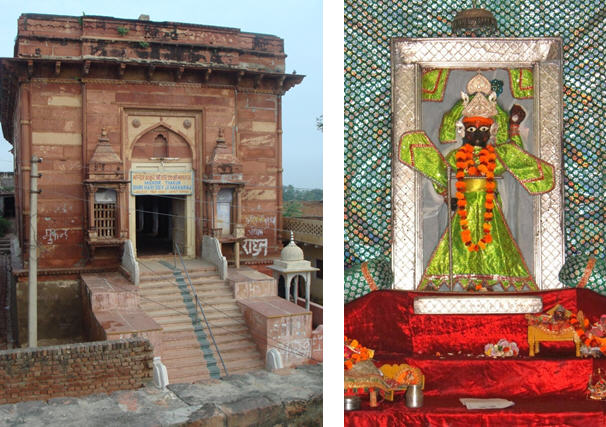
This temple was built by King Bhagandas of Jaipur, whose son, Raja Man Singh, built the Govindaji Temple in the sixteenth century during the reign of Emperor Akbar. The original Deity of Harideva was moved to the town of Rajdhan near Kanpur, when Aurangzeb sent his soldiers to destroy the Deities and temples of Braja. This Deity of Harideva is still at this place.
There is a very wonderful story about: the appearance of Lord Harideva. One day Srimati Radharani and the gopis were waiting for Krsna to come and meet them near Manasi-ganga. As they were waiting, the gopis started to feel intense separation from Krsna. They then began to chant “Harideva, Harideva, Harideva” over and over again, and their feelings of separation intensified so much so, that it appeared they would give up their lives. Suddenly a most beautiful Deity of Krsna as a seven-year-old boy appeared there, holding Govardhana Hill in His left hand and His transcendental flute in the other. The ecstasy Radharani and the gopis felt on seeing that beautiful form knew no bounds. Radharani and the gopis performed all kinds of worship to the Deity and made many wonderful offerings. After the appearance of Govardhana-natha Harideva, Radharani and the gopis would come here every day to worship this beautiful Deity.
Lord Caitanya Mahaprabhu also visited this ancient temple on His pilgrimage to Vrndavana in 1515. Upon seeing the beautiful Deity of Lord Harideva, Lord Caitanya danced in ecstasy for hours. The local Vrajavasis were completly astonished to see Lord Caitanya’s ecstatic love for Lord Harideva.
Reaching there
This temple is about a minute walk from the south bank of Manasi Ganga. After Indra bathed Lord Krishna, all the demigods, holy rivers and sages offered prayers to Lord Krishna and then bathed Him. At this time Brahma also bathed Lord Krishna. Brahma Kunda is the water that collected after Lord Brahma bathed Krishna. Brahma Kunda is located on the southern bank of Manasi Ganga. Lord Brahma permanently resides here. At one time there were also kundas created by Indra (east), Yamaraja (south), Varuna (west), and Kuvera (north) around this kunda. These kundas are now gone. Most of the one hundred and eight kundas situated around Govardhana Hill have also disappeared. It is said that after bathing in Manasi-ganga and having darshana of Harideva, Lord Caitanya Mahaprabhu rested here for some time. Lord Nityananda also rested at Brahma-kunda when He came on pilgrimage to Vraja some years before Lord Caitanya.
Reaching there
This kunda is directly next to the Manasi Devi temple, close to Manasi Ganga and the Harideva temple.
Krishna-Balarama and Nanda Maharaja temple:
Deities (from left to right) of Nanda Maharaja, Balarama, Krishna, Mother Yasoda and Radharani are present. It is said that Nanda Maharaja, Krishna, Balarama and the residences of Braja spent the night here after completing Govardhana Puja.
Reaching there
After coming out of Chakra Tirtha,one may proceed to the left for about 40m (120 ft.), when the road turns left, on your right hand side is this temple.
Post view 897 times



Leave a Reply